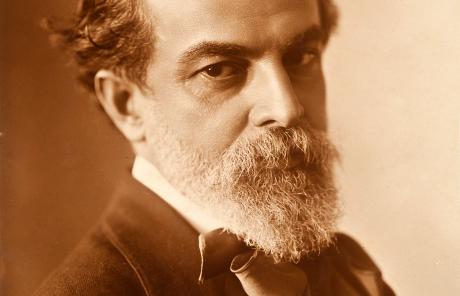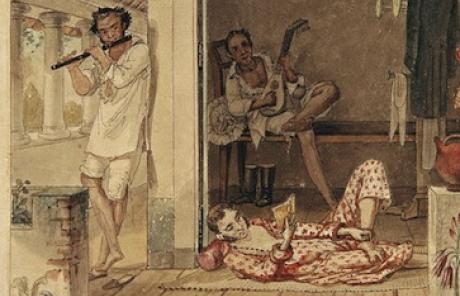What classical music titles say about the compositions they name
Happy and thankful feelings after the storm
Thiago Rocha
This text summarizes what classical music titles convey about the music they name. It simplifies the initial understanding and search for this repertoire, making it easier to write and comprehend these titles in concert programs, inserts, music sheets, applications, the Internet, and more.
Classical music exhibits considerable variation in the structure of its titles. They do not adhere to a single rule but follow certain conventions. This text delves into those conventions.
Most cases can be understood by the structures presented under the subheadings below. The most significant distinction lies between the so-called “specific” titles, which may be evocative (e.g., Floresta Amazônica, Rite of Spring, or Rites of Passage), and “generic” ones, such as Symphony Number 9 (also known as the Ninth Symphony). The latter, the generic titles, require more attention. Though it may seem complicated, it is pretty straightforward.
After reading this text, you will be able to understand titles like String Quartet Number 53 in D Major, “The Lark,” Opus 64, Number 5 – while appreciating simpler titles like The Sea and Little Sonata [Sonatinha].
Structure of the titles
Composition type as a generic title
There are many ways of composing music, some of which are classified as a type or sort of music: the sonata, symphony, minuet, opera, prelude, fugue, rondo, etc. (You can find brief explanations of these on Wikipedia and others that are more specific in books on the History of Music and in those by Charles Rosen, which I mentioned at the end of the text).
When composers explicitly describe their composition style, it is common for them to use the name of that style as the generic title of the music. Music of the same type tends to share more similarities than other types. For example, a sonata will sound more like another sonata than a prelude.
To label a piece as a sonata is to compare it with others of the same kind. When Alban Berg called his first composition a Sonata, he expected people to hear and judge his music according to the sonata tradition.
Instrumentation of the composition as a generic title
In many cases, the generic name of a piece reflects its instrumentation. For instance, works written for string quartets are often called String Quartets. Similarly, there are "Woodwinds Quintet," Clarinet and Piano Duo, Piano and String Quintet, and so on.
Tonality
Most tonal repertoire begins with a definite or definable tonality. The tonality of a piece of music refers to where it hangs harmonically and melodically. There are so-called “major” and “minor” tonalities. Stating the tonality helps differentiate fragments of the same type.
For example, Bach's famous Prelude, which accompanies Gounod's Ave Maria, is in C Major. The “C Major” information distinguishes it from the twenty-three other preludes in the same music sheet book in different tonalities. Thus, we have the Prelude in C Major.
However, Bach also composed other preludes in C Major. Different categories of information are needed to distinguish this specific piece from the others.
Book or Album
Some pieces belong to albums or music sheet books, such as the Prelude in C Major from The Well-Tempered Clavier Book 1.
Examples of similar cases include Robert Schumann's Album for the Young, Chick Corea's "Children's Songs," and J.S. Bach's The Book of Anna Magdalena Bach.
The number of the type of composition or instrumentation number as a generic name
Certain composers wrote many pieces of the same type (e.g., Beethoven wrote thirty-two sonatas) or with the same instrumentation (e.g., Haydn wrote sixty-eight string quartets). In such cases, it is common to include the ordinal number indicating how many pieces of that type or instrumentation the composer has written. For instance, the generic name for Haydn's 53rd string quartet is String Quartet Number 53.
Opus
The first work or musical composition that a composer labels as proper music is called his opus 1 or, in short, op. 1. The second work is labeled as opus 2, and so on. In Latin, the word "opus" means "work." Therefore, the opus number indicates the chronological order of the compositions. Opus 1 could be a solo piano piece, Opus 2 a song, Opus 3 a symphony, and so on. The specific type doesn’t matter; the mentioned examples and Alban Berg's impressive Sonata are considered his Opus 1 (a notable reminder for those aspiring to be called composers).
Opus sub-number
When an opus has a sub-number, it is like an accordion folder; subsequent numbers are subdivisions within that folder. This situation arises when a composer groups certain pieces.
For instance, Beethoven's Opus 2 consists of two piano sonatas that he grouped under that number. To distinguish them, an opus sub-number is used. Therefore, Opus 2 consists of Sonata No. 1 and Sonata No. 2.
Subtitle and (or) Nickname
Some music has subtitles given by the composer. For example, Beethoven's Sixth Symphony is known by the subtitle Pastoral Symphony" or "Recollections of Country Life: More the Expression of Feeling than Tone-Painting. Its full name is Symphony 6 in F Major, Opus 56, Sinfonia Pastoral, or Recollections of Country Life.
Very famous pieces are known by nicknames, either because they evoke some extra-musical ideas or to facilitate the sheet music trade at the time of their release. The Sonata in C Minor, Opus 27, Number 2, Quase uma Fantasia [subtitle], is much better known by its nickname: Moonlight Sonata.
Acronym and catalog or cataloguer number
Sometimes, composers did not mark their music with a sequential number, such as an opus number. Others needed to be more consistent in their markings due to confusion or because the same piece of music was sold to multiple publishers. Each publisher would assign their numbering. For composers like Bach, who composed over a thousand pieces, opus numbers were not used. Mozart and Schubert also displayed inconsistency in their use. In such cases, music is distinguished by an acronym representing the catalog name or the person who cataloged it, followed by a sequential number.
Bach's compositions are distinguished by the acronym BWV, derived from the German Bach-Werke-Verzeichnis, meaning Catalog of Bach's Works. For example, Bach's beautiful Cello Suite No. 1 in G Major is identified as BWV 1007.
Austrian musicologist Ludwig von Köchel cataloged Mozart's works, and the acronym K or KV (for Köchel-Verzeichnis, Köchel Catalog in German) is used to accompany and distinguish Leopold Mozart's son's music. The Requiem in D Minor is designated as K. (or KV) 626.
Schubert's works have opus numbers, but further classification is required for various reasons. Austrian musicologist Otto Erich Deutsch undertook this classification, and his surname is the source of the acronym accompanying Schubert's music. For example, the famous “The Trout” Quintet for Piano and Strings in A Major is called D. 667.
Tempo Marks
Up until now, we have discussed entire pieces. In music, however, there is an equivalent to chapters in literature. In his highly recommended book The Art of the Novel, Milan Kundera states that chapters are the movements, i.e., small complete parts within the whole. Tempo refers to the pace or speed at which the music moves. Common tempo marks include Moderato (Moderate), Allegro (Joyful), etc.
To refer to a movement of the Ninth Symphony that includes a chorus, one would say: Symphony No. 9 in D Minor, Opus 125, IV– Finale. To refer unequivocally to the Gloria of Mozart's Requiem, for example, one would say: Requiem in D Minor is K. 626: Gloria.
Another movement with a famous name is Symphony No. 6 in F Major, Opus 68: V. Allegretto: The Shepherd's Song – Happy and Thankful Feelings after the Storm.
Tempo Mark’s nickname
It is rare, but some movements become known by proper names. This is the case with the fourth movement of Symphony No. 9 mentioned above, known as Ode to Joy, which is the poem’s title written by Schiller and sung in the symphony.
Operas and related vocal compositions
In the case of operas and similar works, there are two further necessary classifications:
Act
The Latin word acto means action. Operas and dramatic texts are divided into large sections called acts. These acts represent significant actions, serving as large units characterized by the closure of a part of the plot. While they do not provide a complete closure, which only happens with the opera's conclusion, they represent partial closures.
The full title of an opera indicates the number of acts it consists of. For example, Yerma, first published by Presto in 2010, has three acts. Therefore, it is referred to as "Yerma, opera in three acts by Heitor Villa-Lobos. To specifically refer to the first act, it is stated as Yerma: Act 1.
Scene
Within each act are further subdivisions called scenes, similar to those found in movies, novels, or plays – for example, Yerma: Act 1, Scene 2.
Nickname or subdivision of scene
It is common to refer to a specific section of a scene by mentioning the names of the characters singing in that section. For instance, Yerma: Act 1, Scene 1, Yerma and Juan.
Abstract Synthesis
The typical structure of a classical music title is as follows:
[Composition Type] in [key], [composition type number], [opus number], [opus sub-number], [Subtitle and/or Surname], [catalog or cataloger's abbreviation] [catalog number]
When referring to a movement:
[Composition Type] in [key], [composition type number], [opus number], [opus sub-number], [Subtitle and/or Surname], [catalog or cataloger's abbreviation] [catalog number]: [movement number], [beginning or main movement tempo], [movement title or surname]
When it is an opera, the structure usually varies to the following:
[Title of Composition], in [number of acts], [opus number], [opus sub-number], [Subtitle and/or Surname], [catalog or cataloger's abbreviation] [catalog number]
And when referring to an opera scene:
[Composition title], in [number of acts], [opus number], [opus sub-number], [Subtitle and/or Surname], [catalog or cataloger's abbreviation] [catalog number]: [act number], [scene number]: [scene name or, when the scene has no name, the characters singing in it]
Further Reading
In increasing order of complexity.
Websites:
What is in a title? (contains a funny video)
What’s in a name? Understanding classical music titles
Catalogues of classical compositions
Classical Music Metadata 101: How to Break Down the Most Complex of Metadata
Books:
Berklee – Teoria da Música, by Paul Schmeling (this one, with book design by Presto)
Fundamentals of Musical Composition, by Arnold Schoenberg
Music and Sentiment, by Charles Rosen
The Classical Style: Haydn, Mozart, Beethoven, by Charles Rosen
The Romantic Generation, by Charles Rosen
Sonata Forms, by Charles Rosen




